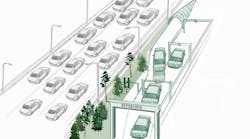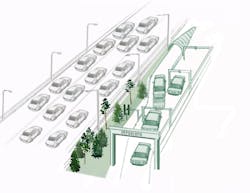Future Infrastructure May Cater to Self-Driving Vehicles, High-Speed Rails
Five finalists in the AEM Infrastructure Vision 2050 challenge presented their concepts for U.S. transportation and infrastructure at the Tech Experience at ConExpo CON/AGG. The winning teams received awards ranging from $15,000 to $50,000 from the Association of Equipment Manufacturers to advance their ideas and businesses. Winners’ submissions cater to the growing demand for fast transportation that will undoubtedly be very high by 2050.
Team Berkeley won first place, accepting a $50,000 prize for their concept of Hyperlane—a separate lane reserved for autonomous cars traveling at speeds up to 120 mph.
UC Berkeley graduate students, Baiyu Chen and Anthony Barrs see self-driving cars as the transportation of the future. Their Hyperlane would take up real estate on existing highways and drive down the price point of constructing new infrastructure like high-speed rails. They expect their Hyperlane concept to be feasible by 2050, as major car companies like Tesla and Ford continue to invest in technologies for self-driving vehicles like car-to-car communications and physical sensors.
Similar to the way Uber and Lyft operate, Hyperlane commuters would hail individual rides or carpool. The Hyperlane would use embedded sensors to ensure safe distances between vehicles, and an air traffic control system would monitor existing traffic for dynamic pricing during peak hours.
Second place winner, Peter Muller from Denver-based PRT Consulting, sees the potential of high-speed rail systems to reduce the number of cars on the road. He earned $35,000 for his concept of a SmART Driverless Vehicle System—a high-speed automated transit network (ATN) employing small pods to connect urban and rural communities.
Based on existing pods at Heathrow airport and other locations, the SmART transit network would transport passengers from point A to point B. Pods would carry up to 4 to 6 passengers at speeds up to 80 mph. Passengers could request pods at any stop along the rail, and a central system would manage supply and demand.
Muller does not dismiss the possibility of using Hyperloop technology in his systems once it is eligible to transport human passengers. (Hyperloop uses a magnetic rail system for transportation at very high speeds.) However, while Hyperloop could be useful for traveling very long distances, it would not be practical for short commutes, he notes.
Third place winner was Kevin Lu from Team Pyro-E. His Adaptive Pavement System would modulate traffic by changing the resistance of the pavement to slow down or speed up autonomous vehicles relative to one another. The system uses small units with RUSH technology, or Regenerative Ultra-Sensory Hotspots to ensure wireless connection with servers and traffic control systems. Connectivity within the system would ensure safe vehicle spacing and reduce congestion. Piezoelectric generators would power the units as cars pass over them. The units would be weather proof and built into the pavement. Watch a video below.
Other finalists in the competition include Jeremy Martinez with a Monorail 2050 concept, and Micheal Ahimbisibwe with a centralized controller that sends instructions to autonomous vehicles and modulates them. Ahimbisibwe's idea would require 5G bandwidth WiFi.
Many of these concepts would rely on developing technologies like 5G WiFi and driverless technology. And indeed, the United States still needs to improve its current infrastructure to be ready for technologies that compensate for increased population. It will be interesting to witness developments in tech, business, and government shaping the future of infrastructure over the next 35 years. Whether the U.S. will be ready to implement above-ground high-speed rails, Hyperloop tech, and driverless cars with automated traffic control by 2050 is yet to be determined.
The panel of judges for the AEM 2050 challenge included Elle Shelley from Local Motors, Adie Tomer from the Brookings Institution’s Metropolitan Policy Program, and Ingrid Reisman from the Las Vegas Monorail Company. AEM, the Association of Equipment Manufacturers comprises more than 900 members in maintenance, construction, and design for roads, rail, and other public infrastructure.



